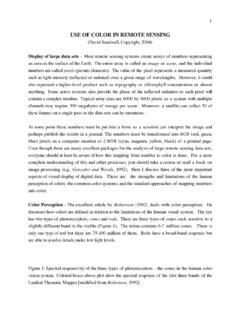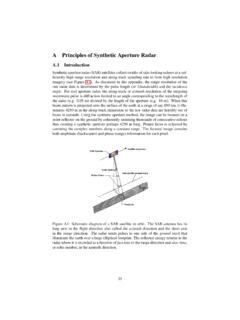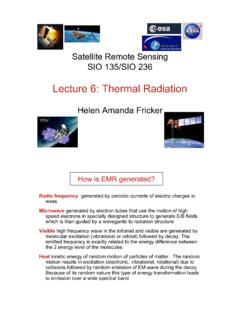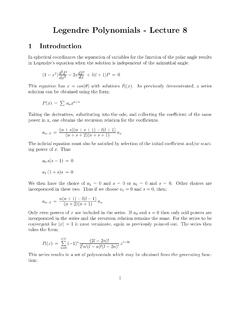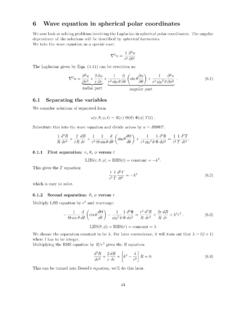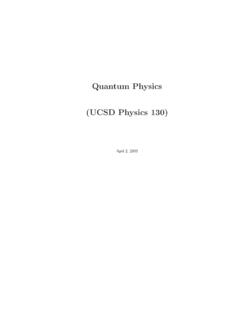Transcription of The Gravity Field of the Earth - Part 1 (Copyright 2002 ...
1 1 The Gravity Field of the Earth - Part 1 (Copyright 2002, David T. Sandwell)This chapter covers physical geodesy - the shape of the Earth and its Gravity Field . This is justelectrostatic theory applied to the Earth . Unlike electrostatics, geodesy is a nightmare of unusualequations, unusual notation, and confusing conventions. There is no clear and concise book onthe topic although Chapter 5 of Turcotte and Schubert is things that make physical geodesy messy include: Earth rotation latitude is measured from the equator instead of the pole; latitude is not the angle from the equator but is referred to the ellipsoid; elevation is measured from a theoretical surface called the geoid; spherical harmonics are defined differently from standard usage; anomalies are defined with respect to an ellipsoid having parameters that are constantly beingupdated; there are many types of anomalies related to various derivatives of the potential.
2 And mks units are not commonly used in the the next couple of lectures, I ll try to present this material with as much simplification aspossible. Part of the reason for the mess is that prior to the launch of artificial satellites,measurements of elevation and gravitational acceleration were all done on the surface of theEarth (land or sea). Since the shape of the Earth is linked to variations in gravitational potential,measurements of acceleration were linked to position measurements both physically and in themathematics. Satellite measurements are made in space well above the complications of thesurface of the Earth , so most of these problems disappear.
3 Here are the two most importantissues related to old-style to satellites and the global positioning system (GPS), elevation was measured with respectto sea level - orthometric height. Indeed, elevation is still defined in this way however, mostmeasurements are made with GPS. The pre-satellite approach to measuring elevation is calledleveling. landorthometric geoidgeometric sea surface spheroid21. Start at sea level and call this zero elevation. (If there were no winds, currents and tidesthen the ocean surface would be an equipotential surface and all shorelines would be atexactly the same potential.)
4 2. Sight a line inland perpendicular to a plumb line. Note that this plumb line will beperpendicular to the equipotential surface and thus is not pointed toward the Measure the height difference and then move the setup inland and to repeat themeasurements until you reach the next shoreline. If all measurements are correct you willbe back to zero elevation assuming the ocean surface is an equipotential artificial satellites measuring geometric height is easier, especially if one is far from Calculate the x,y,z position of each GPS satellite in the constellation using a global Measure the travel time to 4 or more satellites, 3 for position and one for clock Establish your x,y.
5 Z position and convert this to height above the spheroid which we lldefine Go to a table of geoid height and subtract the local geoid height to get the orthometric heightused by all surveyors and heights are useful because water flows downhill in this system while it does notalways flow downhill in the geometric height system. Of course the problem with orthometricheights is that they are very difficult to measure or one must have a precise measurement ofgeoid height. Let geodesists worry about these second complication in the pre-satellite geodesy is the measurement of of surface Gravity measurement is either difficult or trivial depending whether youare on land or at sea, respectively.
6 Consider the land case illustrated variations in the acceleration of Gravity (< 10-6 g) can be measured on the land major problem is that when the measurement is made in a valley, there are masses above theobservation plane. Thus, bringing the Gravity measurement to a common level requires would like to know Gravity on this surface land observations geoid3knowledge of the mass distribution above the observation point. This requires knowledge ofboth the geometric topography and the 3-D density. We could assume a constant density and useleveling to get the orthometric height but we need to convert to geometric height to do thegravity correction.
7 To calculate the geometric height we need to know the geoid but the geoidheight measurement comes from the Gravity measurement so there is no exact solution. Ofcourse one can make some approximations to get around this dilemma but it is still a problemand this is the fundamental reason why many geodesy books are so complicated. Of course ifone could make measurements of both the Gravity and topography on a plane (or sphere) aboveall of the topography, our troubles would be Gravity measurements are much less of a problem because the ocean surface is nearlyequal to the geoid so we can simply define the ocean Gravity measurement as free-air ll get back to all of this again later when we discuss flat- Earth approximations for Gravity (References: Turcotte and Schubert Geodynamics, Ch.)
8 5. p. 198-212; Stacey, Physics ofthe Earth , Ch. 2+3; Jackson, Electrodynamics, Ch. 3; Fowler, The Solid Earth , Ch. 5.)The Gravity Field of the Earth can be decomposed as follows: the main Field due to the total mass of the Earth ; the second harmonic due to the flattening of the Earth by rotation; and anomalies which can be expanded in spherical harmonics or fourier combined main Field and the second harmonic make up the reference Earth model ( ,spheroid, the reference potential, and the reference Gravity ). Deviations from this referencemodel are called elevation, geoid height, deflections of the vertical, and Gravity Earth ModelThe spherical Earth model is a good point to define some of the unusual geodetic terms.
9 Thereare both fundamental constants and derived descriptionformulavalue/unitRemean radius of Earth -6371000 mMemass of x 1024 kgGgravitational 11 m3 kg 1 s 2 mean density of earthMe (4/3 Re 3)-15520 kg m 3 Umean potential energyneeded to take a unitmass from the surfaceof the Earth and placeit at infinite distance-GMeRe -1-6. 26x10-7 m2 s 2gmean acceleration onthe surface of theearth- U/ r = -GMeRe m s 2 g/ rgravity gradient orfree-air correction g/ r = -2 GMeRe 3= -2 x10-6 s 24 We should say a little more about units. Deviations in acceleration from the reference model,described next, are measured in units of milligal (1 mgal = 10-3 cm s-2 =10-5 m s 2 = 10 gravityunits (gu)).
10 As notes above the vertical Gravity gradient is also called the free-air correctionsince it is the first term in the Taylor series expansion for Gravity about the radius of the : How does one measure the mass of the Earth ? The best method is to time the orbitalperiod of an artificial satellite. Indeed measurements of all long-wavelength gravitationaldeviations from the reference model are best done be mass is in orbit about the center of the Earth so the outward centrifugal force is balanced bythe inward gravitational force; this is Kepler s third law. If we measure the radius of the satelliteorbit r and the orbital frequency s, we can estimate GMe.

